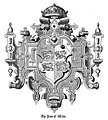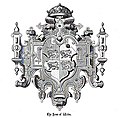English: Coat of arms of Llywelyn the Great, Prince of Wales (see
File:Coat of arms of Wales.svg) within a strapwork surround (style popular during reign of Queen Elizabeth I (1558-1603)) as described in
Annals and Antiquities of the Counties and County Families of Wales: Containing a Record of All Ranks of the Gentry ... with Many Ancient Pedigrees and Memorials of Old and Extinct Families. By Nicholas, Thomas, Published by Longmans, Green, Reader, 1872, p. X.
As described in, "Annals and Antiquities of the Counties and County Families of Wales, 1872":
The Arms of Wales emblazoned on the cover and Frontispiece are the same as those given in the Heraldic Visitations of Wales, by Lewys Dwnn. They were drawn, but without blazon, by Camdeti, and are preserved in the British Museum. The earliest coeval document in which they are mentioned, says Meyrick, is the Life of Foulques Fitz Warren, of the time of Henry III., in the British Museum, which also omits the blazon. In the College of Arms, 2 G. 4, is a representation of quarterings appertaining to Queen Elizabeth, sketched in her time, and here the Arms of Wales are given as—"Quarterly, gules and or, four lions passant guardant counterchanged." In the Harleian Library, British Museum, is a MS., No. 6096, of the same date, wherein he arms appear in like manner. So also in No. 6085 of the Harleian, and L. 14 in the Heralds' College, as well as in an emblazoned MS. by Sir William Segur, dedicated to James I. in the library at Goodrich Court. Hence the arms of Wales have been thus emblazoned here, in a shield placed on a ground of the Tudor colours, as was customary in the days of Elizabeth, and the feathers with their motto, and the crown of the Principality, added on the authority of the seals of Edward IV., and Arthur, son of Henry VII., given in the 2<xh vol. of the Archaologia.
Enderbie, in his Cambria Tritiniphaus, assigns these arms to Rhodri the Great, Prince of all Wales, on the authority of Mills in his Catalogue of Honour, and continues them to his descendants. But the practice of " quartering" arms was not known in the time of Rhodri the Great. It is to be noted that in the quartered arms of Llewelyn the Great, when Prince of all Wales, the lion was passant, as drawn by Camden.


